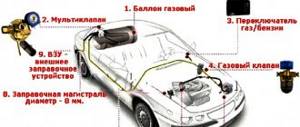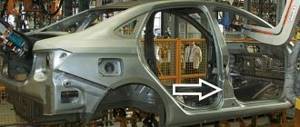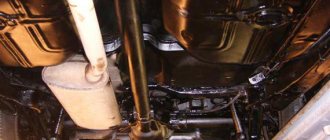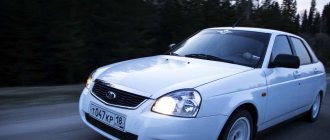One of the worst enemies of a car is moisture. It can penetrate under the paint on the body, as a result of which the metal begins to rot. This process is called corrosion. There are different ways to combat car corrosion, and one of them is galvanizing. The fact is that a galvanized body prevents the penetration of moisture for a long time, but sooner or later even such cars rot. Let's figure out which cars have a galvanized body, and what galvanizing methods there are in general.
Let's start with the fact that such a characteristic cannot guarantee complete protection against rotting of the car. Some manufacturers (European, Japanese, Korean, American) actually produce cars with fully galvanized bodies, while others only partially galvanize some parts. Naturally, the quality will suffer.
To understand how things are with galvanized cars, you first need to understand the three well-known methods of galvanizing a body.
Galvanic galvanizing
Galvanic galvanization can be used for complete body processing, as well as for individual elements. This is a simpler technology for protecting vulnerable areas of the body. The underbody of the car, sills and arches are often galvanized - the places most vulnerable to corrosion. Partial anti-corrosion treatment is used for inexpensive cars that are sold in large quantities.
Chinese cars with galvanized body
Cold galvanizing is advertised only for marketing purposes: the zinc contained in the primed layer is not able to resist corrosion if the paintwork is damaged. Important! Many manufacturers prefer to indicate “galvanized body” in the list of characteristics, meaning partial processing of the most exposed parts: sills, bottom, fenders.
The manufacturer usually characterizes all-round galvanizing with an additional epithet – “full”. We find out which cars have a galvanized body using one of the above methods and the degree of galvanization. Cars with a hot-dip galvanized body. The technology of applying a protective coating using the hot-dip galvanizing method is difficult to implement and requires large investments.
Cold galvanizing
The last method is cold galvanizing. This method is similar to the previous one in technology, but this one is even simpler and cheaper. Some car owners can process body parts using this method in their garages. The car does not need to be immersed in a special zinc-containing solution for this. The solution itself is applied to the body using an electrode, which is connected to the positive terminal (the car body is connected to the negative terminal). Some car repair shops offer a service for processing car body parts, but complete processing cannot be done this way. Since this method is not used by car manufacturers, it is not worth describing it in detail.
Zotye anti-corrosion treatment at the factory
Zoti cars are partially galvanized using the cold galvanizing method, but apparently so partially that the answer to the hotline is “no.” And the Internet is full of evidence that the first red marks begin to appear on the car after just six months. However, Zoti can at least be praised for her honesty, because, as I already said, cold galvanizing only misleads buyers.
This is Zoti, who is only two months old from the date of purchase. Rust is already creeping out from under the bolts. Sad picture. In the end, I would like to say that galvanizing does not mean that the car will last forever. The zinc layer only delays the onset of corrosion, that is, it gives you time to eliminate the shortcomings of the paintwork. The rate of destruction of the zinc layer is approximately 1-6 microns per year, depending on conditions. Zinc is destroyed more actively at high temperatures.
So, if we try to summarize, we can say this: on cheap cars there is no normal galvanization, but on more expensive cars the galvanization will be better. In general, everything is as it should be. However, the good thing about this whole story is that this is where it all began in the article; today it cannot be generalized that all Chinese rust and rot. If you pay a little more and choose a slightly more expensive model, then its quality will be better! This policy from the Chinese cannot but rejoice!
What cars are thermally galvanized?
It is impossible to list all the cars that are produced with galvanized bodies. There are a lot of them, and the list is updated constantly. At a minimum, all Audi and Volkswagen cars manufactured after 2000 have fully galvanized bodies. Also, the following car brands have an anti-corrosion coating applied using heat treatment:
- "Porsche 911."
- Ford Escort.
- Ford Sierra;
- Opel Astra and Vectra (after 1998).
- Volvo 240 and older models.
- "Chevrolet Lacetti".
Why do auto experts prohibit charging mobile gadgets through the cigarette lighter socket?
Tips
In order for the car to get rid of the main problem of Chinese cars, the designers have developed a number of measures for the manufacture of the frame. The first step is hot phosphating, which helps achieve rust resistance. The result is secured by cataphoresis and waxing. After this, the part is sent for painting, where German raw materials are used. Thus, Atlas received high marks in testing paint materials and rust resistance, even in Russian conditions.
Galvanized machines
Cars that have undergone galvanic galvanization:
- "Honda". Accord, CR-V, Legend, Pilot models.
- Chrysler.
- "Audi" (all after the 80th model).
- "Skoda Octavia".
- "Mercedes".
It would take a very long time to list the brands and models of cars, because there are many unknown or little-known manufacturers that make cars with galvanized bodies. There is an opinion among experts that Audi cars have the best bodywork. The concern carries out galvanizing by galvanizing, covering the entire body with an anti-corrosion layer. However, according to reviews, it is known that such well-known cool cars as the Porsche 911 or Volkswagen Passat have bodies that do not rot for decades. Korean manufacturers Kia and Hyundai produce galvanized bodies. The same can be said about the Volvo 240 and many other high-quality cars that have undergone thermal or galvanic galvanization.
As for Chinese or Russian cars, anti-corrosion coating is also applied here, but not on all models. For example, Chinese Cherry cars of the CK and MK series rot quite quickly. Sometimes manufacturers simply deceive the consumer by passing off ordinary cathophoresis primer with an admixture of zinc as a galvanized body.
To broadly generalize, Audi, Volkswagen, BMW, Porsche are the main manufacturers that mainly produce models with fully galvanized bodies. In general, if in the characteristics of a car there is no word “full” next to the term “galvanized,” then we can assume that the anti-corrosion coating is only on some parts of the body. Most often we are talking about the bottom and threshold.
Now you know which cars have a galvanized body, but in any case, when buying a car, you need to clarify this point by checking the technical characteristics.
Chery anti-corrosion treatment at the factory
The article is sponsored by a company that sells Chery on lease
One of the most popular brands. However, Cherie is not doing so well with galvanization. Like Geely, Chery crossovers are divided into old and new. For example, Tiggo 7 and Tiggo 4 are partially galvanized. And the rest of the crossovers (Tiggo 2, 3, 5) are partially galvanized (although the press center said that there is no galvanization at all) and only by cold galvanizing. This is the process of painting the body with primers containing a high content of zinc powder. In a good way, this method cannot be called galvanizing, since zinc particles in the soil do not protect the metal in any way from chips and scratches. It is used more for PR purposes, to use the words “zinc” and “galvanization” in advertising, rather than for real protection against corrosion.
However, you shouldn’t blame Chery either, they have fairly inexpensive cars, which is why they use such a cheap method. The same method is used to “galvanize” the Lada Granta, for example, old Geely models.
Features of thermal galvanization
Considering that there are different zinc methods, it is logical to explain how they differ from each other. As stated above, heat treatment is used only by large European manufacturers. The bottom line is this: the car body is completely immersed in a special zinc-containing solution. After this, the composition is heated to the required temperature, as a result of which the zinc particles stick to the metal. A thin film forms on the surface of the metal, which does not allow moisture to pass through and prevents oxidation.
Cars with such bodies show the best results in salt chambers. Some manufacturers generally give large guarantees for a body that has been processed in this way. Sometimes the warranty period reaches 30 years. The minimum service life of such vehicles is at least 15 years. That is, during all this time the body will not even begin to rust.
Not every manufacturer can afford this technology. As mentioned above, this method is used in cars of the VW Group: Audi, Porsche, Volkswagen, Seat.
Also, some other manufacturers can boast that they make similar bodies. In particular, the body of the Ford Escort is thermally galvanized. The new Opel Astra and Vectra models, as well as the Chevrolet Lacetti, are no exception.
All these cars are more expensive compared to their analogues due to the high cost of implementing such anti-corrosion treatment technology.
Lifan anti-corrosion treatment at the factory
Lifan has exactly the same corrosion protection as Chery. The same cold galvanizing. That is, the cars are simply sprayed with primer and paint containing zinc. Tests in hot salt spray chambers indicate that this protection does not protect against corrosion.
Results of tests of cold galvanizing in hot salt fog. 40 days in such conditions corresponds to 5 years of normal operation.
Lifan X60 after two winters, although an additional anti-corrosion coating was applied
How is galvanizing carried out?
This method is simpler and more concise, but less effective. However, automakers still provide long-term warranties for cars treated in this way.
The process of applying an anti-corrosion layer by galvanic method is simpler:
- The car body or any of its parts is immersed in a container containing an acidic zinc solution.
- The negative terminal from the power source is connected to the body.
- The capacitance itself is connected to the positive terminal.
With this connection, electrolysis occurs in the container. As a result of this process, zinc particles dissolve and stick to the car body. This is how a protective layer is formed, which also prevents the oxidation process and repels moisture. This method is simpler and cheaper. Therefore, machines galvanized by the galvanic method are more affordable. However, the efficiency and service life of such coatings are lower. A body with a thermally applied anti-corrosion coating will resist moisture much longer.
The leaders among automakers that galvanize their cars are BMW and Mercedes.
Haval anti-corrosion treatment at the factory
The Haweil company officially declares and beats its chest that before stamping, the metal sheets are galvanized by the galvanic method - the same as in the previous case with the Atlas. The sheets are immersed in a bath of zinc-containing electrolyte, current is passed through, the zinc is deposited on the metal and galvanization is obtained. Everything is galvanized except the roof (this is normal practice, Atlas and many other automakers do the same).
Haval claims that all models are galvanized using this principle, and not just selected ones. And in fact, the car performed well! Car owners do not have any particular problems with the body.
Partial galvanization
Many manufacturers use only partial galvanization, passing it off as full. This applies primarily to Chinese and Russian brands, as well as some Korean ones and Lada Kalina are partially galvanized. The bodies of these cars are covered with a protective anti-corrosion layer of 40%, but this is not bad either. Here the thresholds and the bottom of the car are treated with an anti-corrosion compound. In this case we are talking about one-sided galvanizing. The second side (inner) is painted and primed using traditional methods.
This approach allows manufacturers to save money and produce budget-class cars designed for mass buyers. But this does not stop people from talking about anti-corrosion treatment in commercials, because it really does take place.
Dongfeng (DFM) anti-corrosion treatment factory
Dongfeng in Russia also sells only one model so far - AX7, but soon there should be a replenishment with models 580 and AX4. The good news is that Dongfeng is assembled at the same plant in Wuhan, China, as Peugeot-Citroens for the Chinese market. So car bodies are galvanized using the same technology, namely the galvanic method. The body is fully galvanized on both sides with a layer of zinc of 9-15 microns.
The result after 40 hours in salt fog (equivalent to five years of operation).











